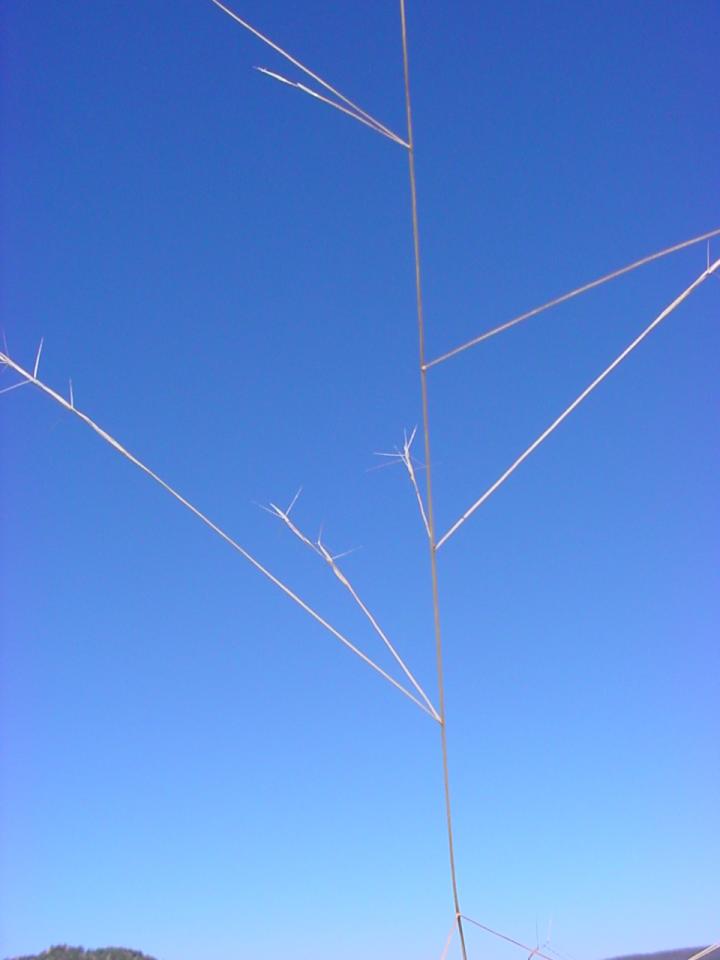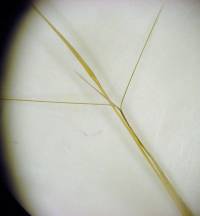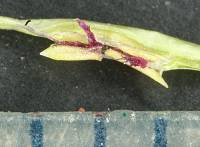- Home
- Search
- Images
- Datasets
- Sample Use
- How to Cite
- Additional Information
- About NEON
- NEON Data Portal
- ASU Biocollections
- About Symbiota
|
|
|
|
Family: Poaceae
poverty threeawn
|
Plants perennial; cespitose. Culms 25-70 cm, erect or prostrate, unbranched or sparingly branched. Leaves tending to be basal; sheaths longer than the internodes, glabrous except at the summit; collars densely pilose; ligules 0.5-1 mm; blades 5-20 cm long, 1-2 mm wide, flat to loosely involute, glabrous. Inflorescences paniculate, 10-30 cm long, 6-25 cm wide, peduncles flattened and easily broken; rachis nodes glabrous or with hairs, hairs to 0.5 mm; primary branches 5-13 cm, stiffly divaricate to reflexed, with axillary pulvini, usually naked on the basal 1/2; secondary branches usually well-developed. Spikelets overlapping, usually appressed, sometimes divergent and the pedicels with axillary pulvini. Glumes 8-12 mm, 1-veined, acuminate or shortly awned, awns to 4 mm; calluses about 0.5 mm; lemmas 8-13 mm long, the terminal 2-3 mm with 4 or more twists when mature, narrowing to 0.1-0.2 mm wide just below the awns, junction with the awns not evident; awns (7)10-20 mm, not disarticulating at maturity; central awns almost straight to curved at the base, ascending to somewhat divergent distally; lateral awns slightly thinner and from much to slightly shorter than the central awns, ascending to divergent; anthers 3, 0.8-1 mm. Caryopses 8-10 mm, light brown. 2n = 22. Aristida divaricata grows on dry hills andplains, especially in pinyon-juniper-grassland zones, from the southwestern United States through Mexico to Guatemala. It occasionally intergrades with A. havardii, but that species has lemma beaks that are straight or have only 1-2 twists, shorter primary branches, usually no secondary branches, and pedicels that more frequently have axillary pulvini so the spikelets are more frequently divergent than in A. divaricata. FNA 2003, Gould 1980 Common Name: poverty threeawn Duration: Perennial Nativity: Native Lifeform: Graminoid General: Tufted perennial grass with slender wiry stems 25-70 cm tall, erect or prostrate, unbranched or sparingly so, sheaths longer than internodes, glabrous except at summit, collars densely pilose. Vegetative: Blades mostly basal, 5-20 cm long, 1-2 mm wide, flat to loosely involute, glabrous, ligules a dense fringe of soft hairs 0.5-1 mm. Inflorescence: Widely spreading panicle 10-30 cm long, 6-25 cm wide, peduncles flattened and easily broken, rachis nodes glabrous or with hairs to 0.5 mm, primary branches 5-13 cm, stiffly divaricate to reflexed, secondary branches usually well developed; spikelets overlapping, usually appressed, sometimes divergent near ends of branches; glumes 8-12 mm, acuminate or shortly awned;, awns to 4 mm; lemmas 8-13 mm long, terminal 2-3 mm with 4 or more twists when mature, narrowing to 0.1-0.2 mm wide just below awns, awns 10-20 mm, not disarticulating at maturity, central awns almost straight to curved at base, lateral awns slightly thinner and from much to slightly shorter than central awns. Ecology: Found on dry open sites, especially in pi-on-juniper woodlands from 4,000-7,000 ft (1219-2134 m); flowers July-October. Distribution: KS to s. CA, south to TX and Guatemala. Notes: This perennial three-awn is distinguished by its panicle with stiffly spreading main branches and appressed spikelets. It also has a long, slender awn column (lemma beak) that is twisted several times, which can be seen with a hand lens. Known to intergrade with A. havardii which has awn columns that are straight or only 1-2 twists, shorter primary branches, usually no secondary branches, and spikelets that are more divergent. Ethnobotany: Ashes of the grass were rubbed on burns. Etymology: Aristida is from the Latin arista for awn, while divaricata means spreading out, referring to the spreading panicle branches. Synonyms: None Editor: SBuckley 2010, AHazelton 2015 |





